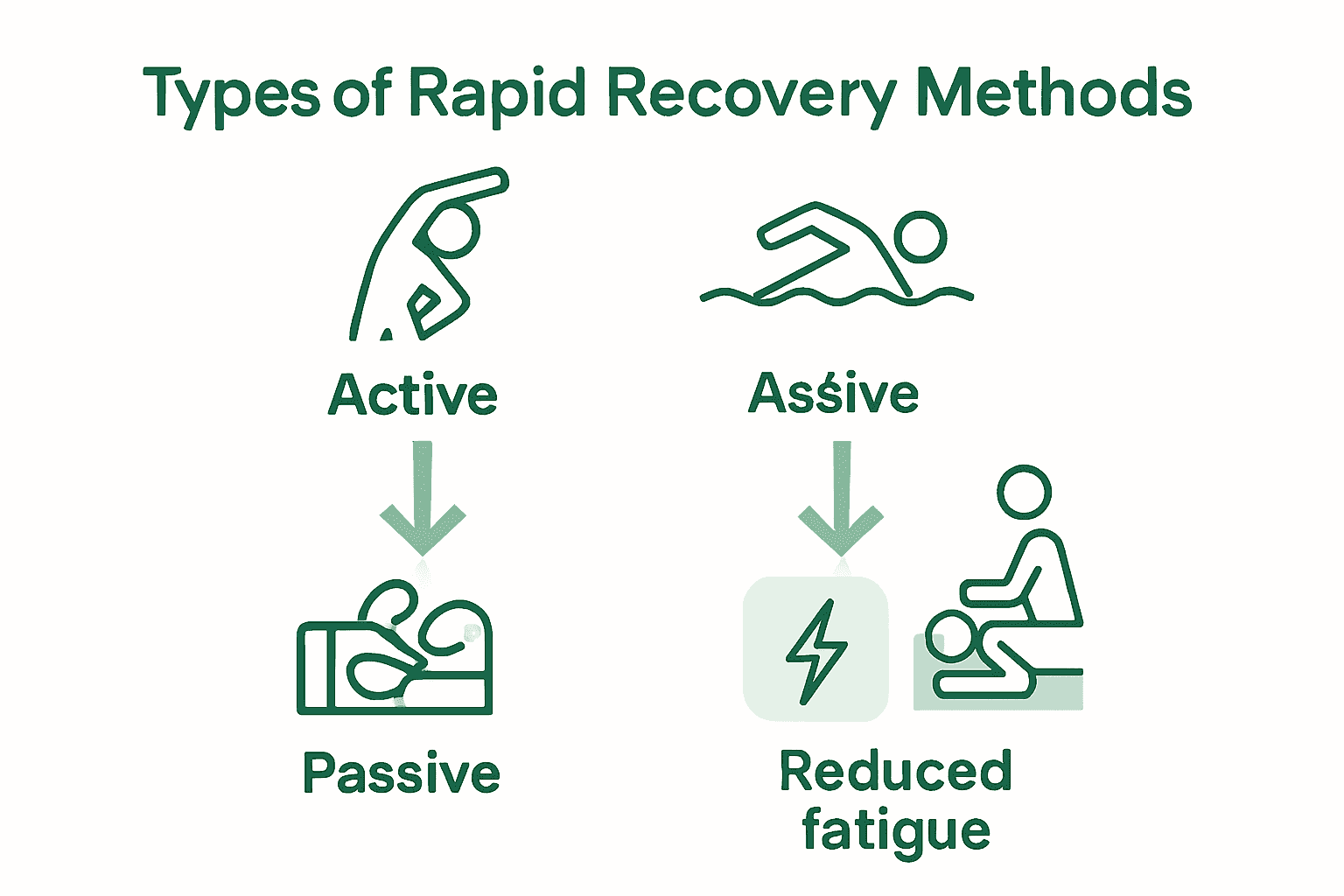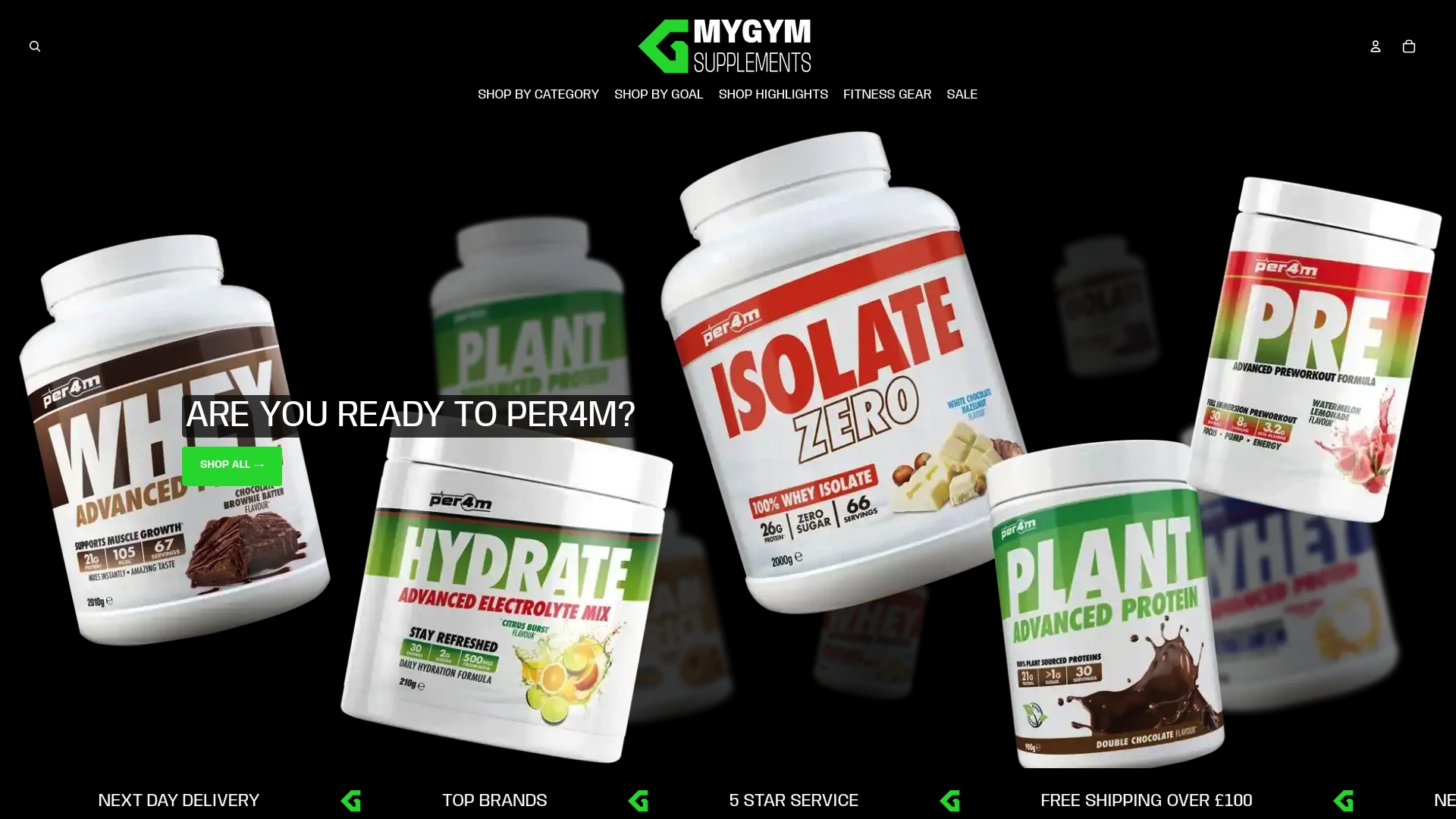Most british athletes know that skipping recovery can cost them progress on every level. In fact, studies show that over 60 percent of gym-goers underestimate the impact of proper rest and targeted recovery techniques. Whether you are pushing for new personal bests or simply want to avoid muscle soreness, rapid recovery is the key to bouncing back stronger and faster. This guide makes it clear how strategic recovery lifts performance while protecting your body from common setbacks.
Table of Contents
- Defining Rapid Recovery In Fitness
- Types Of Rapid Recovery Methods
- Key Benefits For Athletes And Enthusiasts
- Role Of Supplements In Recovery
- Risks, Myths, And Common Pitfalls
Key Takeaways
| Point | Details |
|---|---|
| Rapid Recovery Overview | Rapid recovery focuses on optimising muscle regeneration through active recovery methods and holistic approaches, incorporating movement, nutrition, hydration, and rest. |
| Types of Recovery Methods | Recovery methods include active techniques like light exercise, passive rest strategies, and advanced interventions such as blood flow restriction and hydrotherapy. |
| Benefits for Athletes | Effective recovery strategies lead to reduced muscle fatigue, quicker repair processes, and a lower risk of injury, enhancing overall performance. |
| Importance of Supplements | Targeted supplements play a pivotal role in recovery by providing essential nutrients that aid muscle repair and reduce inflammation. |
Defining Rapid Recovery in Fitness
Rapid recovery represents a strategic approach to muscle regeneration and performance optimisation after intense physical training. According to Marie Claire, active recovery involves low-impact, low-intensity exercises performed following strenuous workout sessions, designed to enhance physiological healing processes.
The core objective of rapid recovery is minimising muscle damage while accelerating the body’s natural repair mechanisms. By engaging in carefully selected recovery techniques, athletes can reduce muscle soreness, improve blood circulation, and expedite metabolic waste removal.
 Active recovery methods typically include light movements like walking, swimming, or gentle stretching that maintain physical activity without placing significant stress on recovering muscle groups.
Active recovery methods typically include light movements like walking, swimming, or gentle stretching that maintain physical activity without placing significant stress on recovering muscle groups.
Understanding rapid recovery requires recognising its multifaceted nature. It encompasses not just physical techniques, but also nutritional support, rest strategies, and targeted interventions. For most fitness enthusiasts, this means implementing a holistic approach that considers:
- Gentle movement post-workout
- Adequate hydration
- Proper nutrition
- Quality sleep
- Strategic supplementation
For more detailed insights into muscle recovery processes, check out our comprehensive guide on muscle recovery.
Types of Rapid Recovery Methods
Athletes and fitness enthusiasts have multiple strategies for accelerating muscle recovery, with each method targeting different physiological processes. According to Men’s Fitness, blood-flow restriction training (BFR) represents an innovative technique that partially restricts blood flow to muscles during low-intensity exercise, promoting muscle growth and expediting recovery mechanisms.
Traditional recovery methods remain fundamental to the process. As Therabody highlights, lifestyle habits play a crucial role in exercise recovery. These approaches can be categorised into several key types:
- Active Recovery Methods
- Light cardiovascular exercise
- Gentle stretching
- Swimming
- Walking
- Passive Recovery Techniques
- Complete rest
- Sleep optimisation
- Compression garments
- Massage therapy
- Advanced Recovery Interventions
- Blood flow restriction training
- Hydrotherapy
- Cryotherapy
- Pneumatic compression
For those looking to enhance their recovery nutrition, our comprehensive guide on post-workout recovery foods offers expert insights into optimising your nutritional strategy.

Key Benefits for Athletes and Enthusiasts
Rapid recovery strategies offer profound advantages for athletes and fitness enthusiasts seeking to optimise their performance and physical well-being. According to Leisure, active recovery significantly increases blood flow to fatigued muscles, facilitating the efficient removal of metabolic waste and substantially reducing muscle soreness.
The physiological benefits extend beyond immediate muscle repair. As Women’s Fitness highlights, implementing strategic recovery approaches can dramatically speed up recovery time, repair microscopic muscle tears, and eliminate lactic acid buildup. These processes directly contribute to improved fitness gains and enhanced athletic performance.
Key benefits of comprehensive rapid recovery include:
- Reduced Muscle Fatigue
- Accelerated Muscle Repair
- Enhanced Metabolic Waste Removal
- Improved Muscle Flexibility
- Decreased Risk of Injury
- Optimised Performance Potential
- Faster Adaptation to Training Stimuli
Athletes seeking to dive deeper into nutritional strategies that support recovery can explore our guide to sports nutrition basics for comprehensive insights into maximising fitness results.
Role of Supplements in Recovery
Supplements play a critical role in optimising muscle recovery and supporting overall athletic performance. According to Brian Mac, post-exercise nutrition is fundamental, with research highlighting the importance of a precise nutritional approach that includes a strategic combination of carbohydrates and protein to replenish glycogen stores and facilitate muscle repair.
The most effective recovery supplements target specific physiological processes, helping athletes reduce muscle breakdown, accelerate healing, and enhance adaptive responses. These nutritional interventions work by providing targeted nutrients that support cellular repair, reduce inflammation, and promote protein synthesis. Key supplement categories include proteins, amino acids, electrolyte replacements, and micronutrient complexes designed to address the unique metabolic demands of intense physical training.
Primary supplement types for recovery include:
- Protein Powders
- Branched-Chain Amino Acids (BCAAs)
- Creatine Monohydrate
- Glutamine
- Electrolyte Replenishers
- Omega-3 Fatty Acids
- Antioxidant Complexes
For athletes seeking a comprehensive understanding of targeted recovery nutrition, our guide on amino acids for recovery offers in-depth insights into optimising supplement strategies.
Risks, Myths, and Common Pitfalls
Navigating recovery strategies requires understanding potential risks and debunking common misconceptions that can hinder athletic performance. According to Explore Now, overtraining without adequate recovery can dramatically decrease performance and significantly increase injury risk, highlighting the critical importance of strategic rest and recuperation.
Many athletes fall prey to widespread myths about recovery that can compromise their fitness journey. As Amnesty emphasises, neglecting fundamental recovery principles such as sufficient sleep and balanced nutrition can substantially impede fitness progress and elevate the likelihood of overtraining-related injuries.
Common recovery myths and risks include:
- Myth: More Training Always Equals Better Results
- Reality: Rest is crucial for muscle adaptation
- Overtraining leads to decreased performance
- Increased injury susceptibility
- Myth: Recovery is Passive
- Active recovery strategies are more effective
- Targeted interventions accelerate healing
- Strategic rest promotes muscle growth
- Significant Risks
- Chronic fatigue
- Reduced immune function
- Hormonal imbalances
- Increased inflammation
- Muscle breakdown
Athletes wanting to dive deeper into understanding recovery nuances can explore our guide on amino acids for recovery for comprehensive insights into optimising their regeneration strategies.
Speed Up Your Muscle Recovery with Targeted Nutrition
Rapid recovery is essential for anyone serious about fitness and performance. After intense workouts, your body needs precise support to minimise muscle soreness, reduce fatigue, and maximise repair. This is where the right supplements come into play. Whether you are aiming to enhance muscle repair, flush out metabolic waste, or reduce injury risk rapid recovery strategies powered by quality nutrition can make all the difference.

Discover how you can transform your recovery routine by exploring top recovery aids on MyGymSupplements.shop. Our selection includes effective proteins, amino acids, electrolytes, and performance recovery solutions designed to accelerate muscle healing and boost your fitness results. Take control of your fitness journey today and visit our performance recovery aids category to start feeling stronger and more resilient after every workout.
Frequently Asked Questions
What are rapid recovery methods in fitness?
Rapid recovery methods in fitness refer to various techniques and practices aimed at optimising muscle regeneration and performance after intense physical activity. These methods include active recovery exercises, passive recovery techniques, and advanced interventions like blood flow restriction training and cryotherapy.
How does active recovery benefit muscle recovery?
Active recovery benefits muscle recovery by promoting blood circulation to fatigued muscles, which helps remove metabolic waste, reduce muscle soreness, and support the natural healing processes in the body. Activities like walking, gentle stretching, and swimming are effective forms of active recovery.
What role do supplements play in muscle recovery?
Supplements play a critical role in muscle recovery by providing essential nutrients that help replenish glycogen stores, reduce muscle breakdown, and accelerate healing. Common supplements used for recovery include protein powders, branched-chain amino acids (BCAAs), and electrolyte replenishers.
What are some common myths about muscle recovery?
Common myths about muscle recovery include the belief that more training always leads to better results, that recovery is a passive process, and that neglecting recovery won’t impact performance. In reality, strategic rest and active recovery are essential for optimal performance and preventing injuries.
Recommended
- What Is Muscle Recovery? A Complete Overview – MyGymSupplements
- 7 Best Post-Workout Recovery Foods for Fitness Results – MyGymSupplements
- 7 Essential Types of Performance Enhancers Explained – MyGymSupplements
- Best Vitamins for Muscle Recovery – Expert Comparison 2025 – MyGymSupplements
- Shockwave Therapy for Athletes Guide to Faster Recovery - Regentech Physical Therapy
- Regenerative Physical Therapy: Complete Guide to Recovery - Regentech Physical Therapy



0 comments